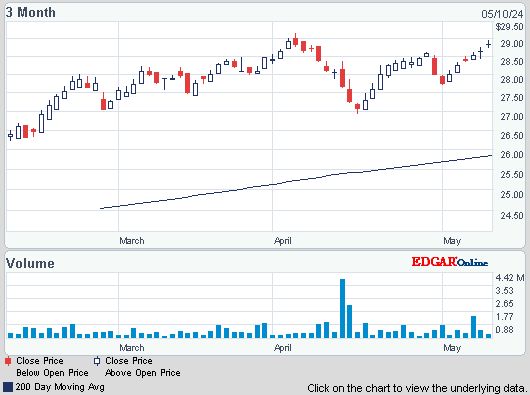Dow dropped 109, decliners over advancers 5-2 & NAZ dropped 34. The Financial Index was off 3 to 241 (a 1 month low). The MLP index fell 3 to the 442s (a 2 week low) & the REIT index was off 1+ to 290. Junk bond funds slid lower & Treasuries soared on the news of a weaker economy. Oil is heading
for the biggest weekly drop in 6 months as US employers
hired less than half the number of workers forecast in Mar,
raising concern that economic growth won’t be strong enough to
support oil demand. But gold rose on that very same thinking.
AMJ (Alerian MLP Index tracking fund)



Photo: Bloomberg
Employers hired fewer workers than forecast in Mar & a slump in the size of the labor force pushed the jobless rate down to a 4-year low, indicating the US job market is struggling to make bigger strides. Payrolls grew by only 88K, the smallest gain in 9 months & less than the most-pessimistic forecast, after a revised 268K Feb increase, according to the Labor Dept. The forecast called for a 190K gain. The jobless rate fell to 7.6% from 7.7%, the lowest since Dec 2008, reflected a 496K decline in the size of the labor force. The labor force participation rate fell to 63.3%, the lowest since May 1979. Some companies are struggling to make do with fewer workers.
Job Gains Slow as Unemployment Rate Falls to Four-Year Low

Photo: Yahoo
The US trade deficit unexpectedly narrowed in Feb as exports climbed close to an all-time high & the volume of imported crude oil fell to the lowest level in 17 years. The gap between exports & imports shrank to $43B, down 3.4% from the revised $44.5B in Jan, according to the Commerce Dep. It was the smallest trade imbalance since Dec when the gap had declined to $38B, the lowest point in nearly 3 years. Exports rose 0.8% to $186B, close to the record high set in Dec. Stronger exports of US energy products & autos offset declines in sales of airplanes & farm equipment. Imports were flat at $229B with the volume of crude oil falling to the lowest point since Mar 1996. The deficit with China shrank to $23.4B, the lowest point in 11 months. Exports to the EU were down 0.9% in Feb, compared to Jan, reflecting continued economic weakness as that region struggles with a recession triggered by a debt crisis. Thru the first 2 months of this year, the trade deficit is running at an annual rate of $525B, down slightly from last year's $539B imbalance. The deficit this year may narrow slightly, in part because of continued gains in US energy exports. A narrower trade gap boosts growth because it means US companies are earning more from overseas sales while US consumers & businesses are spending less on foreign products.
Trade Deficit in U.S. Unexpectedly Narrows on Oil Imports
The outlook for Spain’s banks remains negative as recession threatens to push up loan defaults across all asset classes in the euro area’s 4th-largest economy, Moody’s said. “The main driver of the outlook is the rating agency’s expectation that the banks will continue to operate in a recessionary environment burdened by high levels of non- performing assets that are expected to significantly deteriorate further,” Moody’s said. An economic slump entering its 6th year is driving up loan defaults for banks already struggling with the impact of low interest rates & weak credit demand. Bad loans as a proportion of total lending stand at 10.8% after about €160B ($208B) of credit t4rned sour 4 years ago. Moody’s is monitoring the impact of legal rulings & gov decisions that could affect Spain’s €600B euro stock of mortgages. The gov announced proposals in Jan that may widen the scope for partial mortgage debt forgiveness, while the European Court of Justice ruled against Spain’s legal framework, which it considered to be in violation of consumer protection laws. Any potential increase in residential mortgage losses “could challenge the solvency of a much broader group of banks than those having suffered from the real estate crisis and could increase the negative rating pressure for most Spanish banks,” Moody’s said. The euro debt mess is far from over.
Moody’s Says Outlook for Spanish Banks Remains Negative
AMJ (Alerian MLP Index tracking fund)
Treasury yields:
U.S. 3-month |
0.063% | |
U.S. 2-year |
0.224% | |
U.S. 10-year |
1.687% |
| CLK13.NYM | ...Crude Oil May 13 | ...92.49 | (0.8%) |
| GCJ13.CMX | ....Gold Apr 13 | .......1,566.00 | (0.9%) |

Photo: Bloomberg
Employers hired fewer workers than forecast in Mar & a slump in the size of the labor force pushed the jobless rate down to a 4-year low, indicating the US job market is struggling to make bigger strides. Payrolls grew by only 88K, the smallest gain in 9 months & less than the most-pessimistic forecast, after a revised 268K Feb increase, according to the Labor Dept. The forecast called for a 190K gain. The jobless rate fell to 7.6% from 7.7%, the lowest since Dec 2008, reflected a 496K decline in the size of the labor force. The labor force participation rate fell to 63.3%, the lowest since May 1979. Some companies are struggling to make do with fewer workers.
Job Gains Slow as Unemployment Rate Falls to Four-Year Low

Photo: Yahoo
The US trade deficit unexpectedly narrowed in Feb as exports climbed close to an all-time high & the volume of imported crude oil fell to the lowest level in 17 years. The gap between exports & imports shrank to $43B, down 3.4% from the revised $44.5B in Jan, according to the Commerce Dep. It was the smallest trade imbalance since Dec when the gap had declined to $38B, the lowest point in nearly 3 years. Exports rose 0.8% to $186B, close to the record high set in Dec. Stronger exports of US energy products & autos offset declines in sales of airplanes & farm equipment. Imports were flat at $229B with the volume of crude oil falling to the lowest point since Mar 1996. The deficit with China shrank to $23.4B, the lowest point in 11 months. Exports to the EU were down 0.9% in Feb, compared to Jan, reflecting continued economic weakness as that region struggles with a recession triggered by a debt crisis. Thru the first 2 months of this year, the trade deficit is running at an annual rate of $525B, down slightly from last year's $539B imbalance. The deficit this year may narrow slightly, in part because of continued gains in US energy exports. A narrower trade gap boosts growth because it means US companies are earning more from overseas sales while US consumers & businesses are spending less on foreign products.
Trade Deficit in U.S. Unexpectedly Narrows on Oil Imports
The outlook for Spain’s banks remains negative as recession threatens to push up loan defaults across all asset classes in the euro area’s 4th-largest economy, Moody’s said. “The main driver of the outlook is the rating agency’s expectation that the banks will continue to operate in a recessionary environment burdened by high levels of non- performing assets that are expected to significantly deteriorate further,” Moody’s said. An economic slump entering its 6th year is driving up loan defaults for banks already struggling with the impact of low interest rates & weak credit demand. Bad loans as a proportion of total lending stand at 10.8% after about €160B ($208B) of credit t4rned sour 4 years ago. Moody’s is monitoring the impact of legal rulings & gov decisions that could affect Spain’s €600B euro stock of mortgages. The gov announced proposals in Jan that may widen the scope for partial mortgage debt forgiveness, while the European Court of Justice ruled against Spain’s legal framework, which it considered to be in violation of consumer protection laws. Any potential increase in residential mortgage losses “could challenge the solvency of a much broader group of banks than those having suffered from the real estate crisis and could increase the negative rating pressure for most Spanish banks,” Moody’s said. The euro debt mess is far from over.
Moody’s Says Outlook for Spanish Banks Remains Negative
Early signals on weaker Mar economic activity got little attention. But the jobs report today was too much for even the most ardent bulls to ignore. Dow is off 68 this week (or month) & more selling may lie ahead. The next macro economic reports should reflect more dreary numbers & earnings season kicks off on Tues evening. Apr may be a month for stocks to pause in their rally, Dow is still up1K since mid Nov.
Dow Jones Industrials










No comments:
Post a Comment